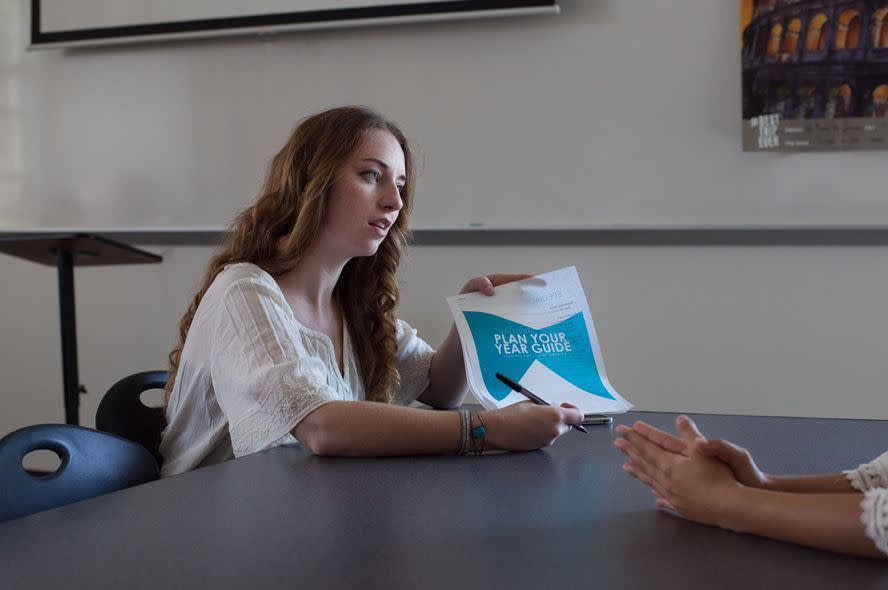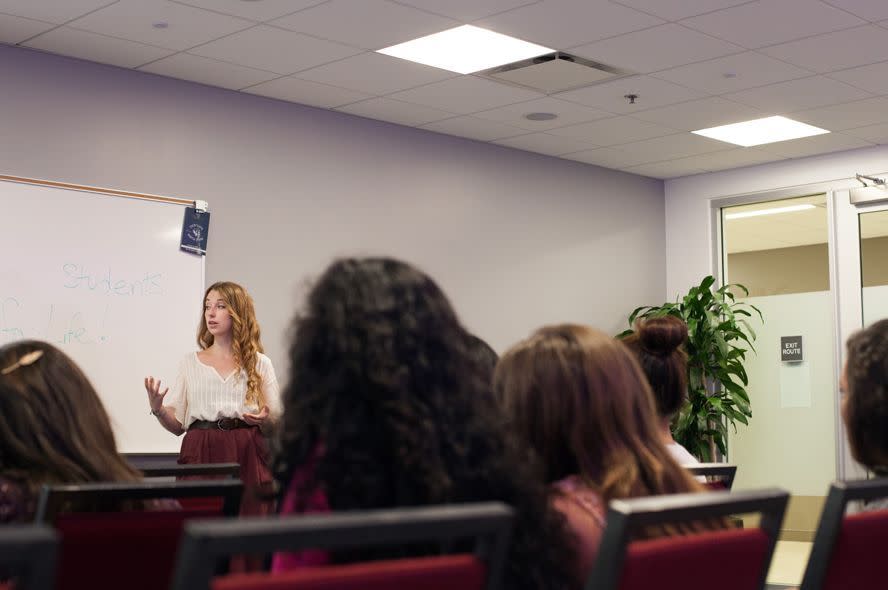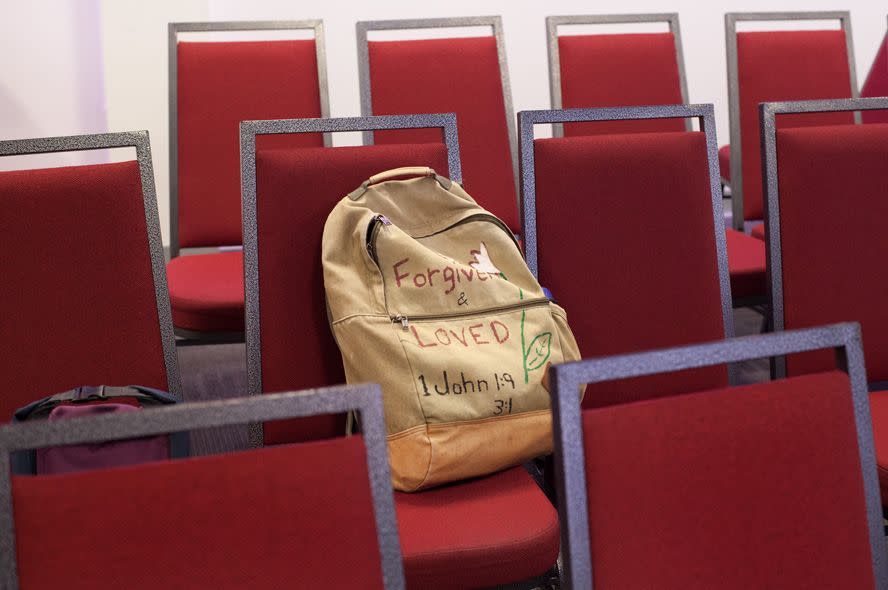Meet The Pro-Life Millennial

PHOTOGRAPHED BY JOHN FRANCIS PETERS.
Projected onto a screen at the front of the room, a sepia-tinted orb gently pulses in a black abyss. Violin music swells as two circles suddenly appear inside the orb, quickly dividing into four, then eight, then too many to count. The words 24 hours. Baby’s first division appear on the screen.
The audience watches in respectful silence as the YouTube video progresses through the initial stages of human development — the miracle of life played out against a high-drama score. They are members of a anti-abortion student group at California State University in Northridge, where they have gathered in a chilly conference room on a sunny day in September to welcome a special guest: Emily Wilkinson, the 27-year-old West Coast regional coordinator of Students for Life, an anti-abortion network with 800 chapters at colleges and high schools across the country.
Related: 30 Photos Of Unretouched Butts, In Case You Forgot What They Really Look Like
As the video ends, Wilkinson stands to address the group. “Thank you, guys! So good to be here,” she says. She is poised and smiling in a peasant skirt and Birkenstocks, a tiny braid woven into her long, auburn curls. “It’s exciting that school’s back in session, and it’s time to start making a difference on campus again,” she says in a warm but resonant tone.
Though the group is small — just six female students and two male faculty members have shown up today — but their mission is grand: “To abolish abortion in our lifetime,” Wilkinson says. To do that, she goes on, “we must make abortion unthinkable."
Related: 25 Real Photos Of Women’s Breasts (NSFW)
So, I do. I picture a world where no woman would ever have to think about having an abortion: a world where, somehow, we’ve eliminated the possibility of unwanted or unsafe pregnancy. There would be no legal battles over a woman’s body, no hard choices, no need to choose at all. I mean, yeah, that world sounds wonderful. It’s just not this world.
Twenty years ago, the national debate over abortion was quite literally a street fight. Many people, particularly within the generation born after Roe v. Wade, still associate the anti-abortion movement with screeching protesters, the murders of doctors who performed procedures, and, more recently, the firebombing of clinics in Washington state and California. Certainly, that’s how I saw it, until I met Wilkinson.
Related: What Losing 110 Pounds REALLY Looks Like
She and her peers refer to themselves as part of the "pro-life generation,” and there are more of them than you might imagine. While Americans in general have been inching toward the anti-abortion camp over the past two decades, the shift in opinion among millennials is more pronounced. According to a Gallup poll, 23% of young adults now say that abortion should be illegal in all circumstances — higher than in any other demographic.
Many other millennials are uncomfortable identifying themselves exclusively as anti-abortion, but only 27% now identify as exclusively pro-abortion rights, according to another poll, conducted by the Public Religion Research Institute, which also found that 35% of millennials believe abortion is morally unacceptable.
The anti-abortion movement is no longer one relegated to the few and fanatical. It’s a war being waged in statehouses, in America’s highest courts, and in student conference rooms like this one. And with abortion rights and access being whittled away across the country, anti-abortion activists must be recognized as the widespread, vital force they are. Today’s anti-abortion shock troops are young people of no particular background or religion, organized in a diverse mosaic of groups that include the Jewish Pro-Life Foundation, Pro-Life Quakers, Secular Pro-Life, Pro-Life Pagans, the Pro-Life Alliance of Gays and Lesbians, and Feminists for Life (whose motto is “Refuse to choose. Women deserve better”).
Related: The True Story Of Eyebrow Transplants
In other words, Wilkinson is not the new voice of the anti-abortion movement but one of many new voices.
“I attribute that to the fact that since abortion was legalized, so many women have had abortions that those women are now our aunts, our mothers, our sisters, our friends,” she tells me. “I think that it’s just that the truth is coming out. So many people have experienced it and been hurt by it that they want to do something about it.”
The research might counter her on that point, but I’m not here to debate but rather to listen and learn (and bite my tongue, if only for a day). I joined Wilkinson on a typical workday; she spends much of her week on the road, visiting schools up and down the West Coast to help campus activists flesh out their annual plans and deliver energetic presentations like this one at Cal State, Northridge. She’s there to remind them that today’s battleground over abortion is right before their eyes.
“Frankly, if you look around [this campus], you probably don’t see any pregnant women. And you probably don’t see that many pregnancy resources,” she tells the group. Where anti-abortion advocates of yore may have focused on the fetus, Wilkinson draws attention to the future mother — specifically, pregnant women on campus. “They are the target demographic,” says Wilkinson. “Five hundred thousand college-age women will have an abortion each year."
Related: This 30-Day Upper-Body Challenge Will Transform Your Arms & Shoulders
But there is no talk of shame or murder in this room, no condemnation. Instead, Wilkinson urges the need to create a supportive environment for the student who finds herself pregnant. "She’s going to wonder, ‘Well, I don’t see any pregnant women. I don’t see any diaper decks. I don’t see any lactation rooms. I don’t see any family housing. I’m going to lose my scholarship.” She pauses. “Unless you change that,” she tells her audience. “And if you don’t, then every campus is going to be a hostile environment to a pregnant woman.”
Regardless of her stance on the issue, no pro-abortion-rights woman would argue against making college a better place for pregnant women and mothers. And Wilkinson knows it. “First of all, look for common ground — because there is. And it’s not something to be afraid of,” she says. She urges her fellow activists to welcome “the haters,” even if it means putting up with some vocal abuse. “We’re trying to win hearts and people, not arguments,” she says. “If people don’t feel that you respect them, then they’re not going to respect you.” No matter what, you have to cultivate “a really compassionate outlook on everyone you talk to.”
Related: The Secret To The Perfect Plank
This, I realize, is the secret weapon of the anti-abortion movement that doesn’t end up in the news: empathy.

Emily Wilkinson wasn’t raised to be an activist, but she did grow up in an anti-abortion home. Thanks to her dad’s job as a business and marketing professor, she spent her childhood hopscotching all over the country, before settling in Montana for her teen and college years. Wilkinson’s first awareness of abortion came, she tells me, when her parents took her to an anti-abortion rally when she was 9.
It made a big impression. “Some state legislator got up and spoke, and my mom told me to cover my ears,” she says. “Of course, I didn’t cover my ears. And he described a partial-birth abortion. [Ed. note: This procedure is known in the medical community as an intact dilatation and extraction and is recommended in rare circumstances.] That was very shocking, very sickening to me as a child, you know? When you find out something horrible existed that you never knew about before, your heart sinks a little and you’re like, ‘Oh, the world is worse than I thought.’”
Related: The Secret To The Perfect Plank
After that, Wilkinson says, “I always had this tug to be involved.” She started anti-abortion groups in high school at college. After graduating, she spent three years working at an anti-abortion pregnancy-resource center, and in 2014 she became one of 18 full-time staffers at Students for Life.
Hers is not a faith-based calling, although Wilkinson is a member of the Eastern Orthodox Church. Religion doesn’t even come up until I ask her about it, and even then she admits that some religious organizations can be part of the problem. For instance, “if you don’t want the members of your church or school to be having sex, then you better be talking about it,” she says. “It’s something pastors or Christian schools sometimes just ignore because they think it’s not affecting them.”
Related: 4 Crazy Makeup Hacks You Need To Learn Now
So, does she implicate the church for more kids getting pregnant and having abortions? Not exactly. But…"because Christians view sex before marriage as wrong or a sin, students who get pregnant could want to hide that fact,“ says Wilkinson, deftly laying out her argument while easing her little red Hyundai back onto the freeway. "Churches and schools need to recognize that when people mess up, you help them through it. They don’t get kicked out or get shunned. No, they get support and love. That’s something that we tell students. If that’s lacking in a school, then you be that support, so if a girl gets pregnant, she knows exactly who to talk to.”

We walk into the administration office of a Los Angeles-area high school shortly after the lunch bell rings and meet Sarah (we’ve changed her name because she’s a minor), a senior trying to start her own Students for Life chapter at the school. Small and blonde, with a bubbly blue shimmer brushed on her eyelids, she’s the kind of 17-year-old who looks closer to 12. But, just like Wilkinson, Sarah is vocal and confident in her beliefs, even when it’s hard. “A lot of people [in school] are pro-choice just because it’s cool to be 'different,’” she explains.
Wilkinson nods and smiles, saying that when she was in school, being anti-abortion “was the un-coolest position to have.” But it’s people like Sarah, she says, who are “showing people that it’s nothing to be ashamed of.”
Sarah brightens further under Wilkinson’s praise and goes on: “It’s all over the media. I don’t want people reading biased pro-choice articles about what’s happening.”
“Yeah,” Wilkinson nods. “Do you think most people on campus know about Planned Parenthood?”
Related: All The Boob Questions You Were Afraid To Ask, ANSWERED
Planned Parenthood, of course, is the primary target of anti-abortion advocates in the U.S., and right now, the organization is in the crosshairs. In July, an anti-abortion group released a series of hidden-camera videos that purported to show Planned Parenthood employees making arrangements to illegally sell aborted fetal tissue to medical labs. The videos were widely criticized for having been deceptively edited, but Planned Parenthood critics in Congress jumped on them as ammo to withdraw the group’s federal funding. Nevertheless, Sarah says, most students in her school have a neutral or positive view of Planned Parenthood, seeing it “as, you know, women’s health.”
Wilkinson quickly supplies her with a perfect counterpoint to offer her classmates: “the 3% myth.” She’s referring to the fact that Planned Parenthood reports that abortions account for only 3% of the services the group provides. Though technically accurate, critics have called this a problematic statistic, primarily by claiming it doesn’t reflect the percentage of income generated by abortion procedures. But numbers are beside the point, says Wilkinson, when you’re talking about abortion.
By Kelsey Miller

